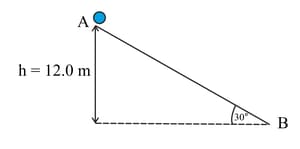K A Tsokos Solutions for Chapter: Mechanics, Exercise 3: Test yourself
K A Tsokos Physics Solutions for Exercise - K A Tsokos Solutions for Chapter: Mechanics, Exercise 3: Test yourself
Attempt the practice questions on Chapter 2: Mechanics, Exercise 3: Test yourself with hints and solutions to strengthen your understanding. Physics for the IB Diploma 6th Edition solutions are prepared by Experienced Embibe Experts.
Questions from K A Tsokos Solutions for Chapter: Mechanics, Exercise 3: Test yourself with Hints & Solutions
A block of mass and an initial speed of slides on a rough horizontal surface and is eventually brought to rest after travelling a distance of . Calculate the frictional force between the block and the surface.
A spring of spring constant is slowly extended from an extension of to an extension of . Calculate the work done by the extending force.
The speed of the mass in position in the diagram is . By the time it gets to the speed is measured to be .

Estimate the frictional force opposing the motion. (The frictional force is acting along the plane.)
A mass of slides down a frictionless incline of to the horizontal. The mass starts from rest from a height of .
Sketch a graph of kinetic energy and potential energies of the mass as a function of distance travelled along the incline.
A mass of slides down a frictionless incline of to the horizontal. The mass starts from rest from a height of .
On each graph, sketch the sum of the potential and kinetic energies.
A battery toy car of mass is made to move up an inclined plane that makes an angle of with the horizontal. The car starts from rest and its motor provides a constant acceleration of for . The motor is then turned off
State the periods in the car's motion in which its mechanical energy is conserved.
A battery toy car of mass is made to move up an inclined plane that makes an angle of with the horizontal. The car starts from rest and its motor provides a constant acceleration of for . The motor is then turned off.
Estimate the average power developed by the car's motor.
A battery toy car of mass is made to move up an inclined plane that makes an angle of with the horizontal. The car starts from rest and its motor provides a constant acceleration of for . The motor is then turned off.
Determine the maximum power developed by the motor.
